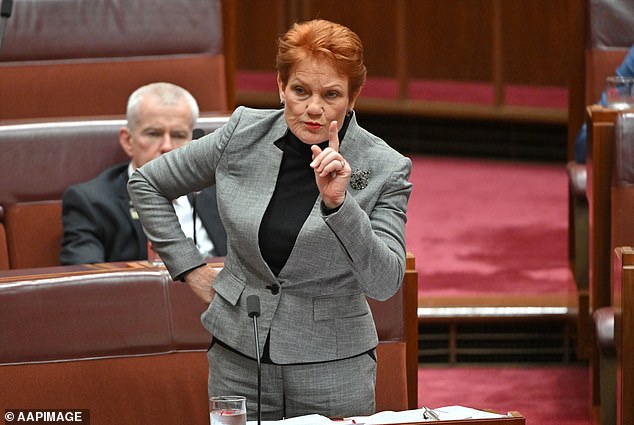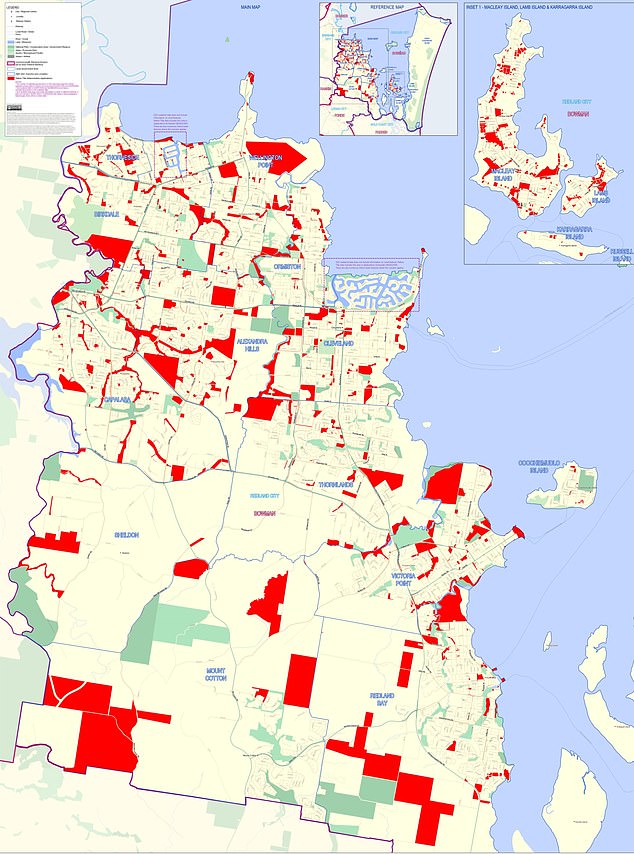Stunning map shows the extent of Native Title control in Australia – as senator warns there are many more Aboriginal claims to come: Here’s what it means for you
A stunning map has revealed that Native Title, a legal recognition of Aboriginal rights over an area, covers almost half of Australia’s landmass.
Indigenous rights holders can receive compensation for things that the government has done to prevent them from exercising their rights, such as building a bridge or a road.
The map, drawn up by the National Native Title Tribunal, shows that around 50 percent of Australia is under Native Title, with the sections separated by dark and light green to distinguish between ‘exclusive’ and ‘non-exclusive’ zones .
A further 12 percent of the land is assessed for native title, with these areas coded in blue spots or stripes.
It is important to note that Native Title can only be claimed on Crown land and does not apply to privately owned properties.
When a provision of native title specifies ‘exclusive’ rights, it means that the indigenous group has exclusive ownership and control of the area in question, to the exclusion of all others, including government agencies and non-indigenous individuals or entities.
Non-exclusive native title in Australia grants indigenous groups shared rights and interests in land without exclusive control.
It can grant native title holders the right to local cultural practices, such as the right to live in the area, hunt, fish, gather food or teach the laws and customs of the land.
A stunning map has revealed that Native Title extends across half of Australia, with more claims currently being assessed in other parts of the country
To claim native title it is necessary to demonstrate an enduring connection to the land through pre-European tribal laws and customs. Claims are registered with the National Native Title Tribunal and resolved by courts including the Federal Court or the Supreme Court and the State Supreme Courts.
On Tuesday, Senator Pauline Hanson pushed for a royal commission into Native Title, but her bid was rightly voted down, with only five other senators supporting the motion.
“Under current law, there is an infinite period in which claims can be made,” she explained. “That means that groups will still be able to make claims in a hundred years.”
She said that by removing federal funding from respondents but continuing to provide money to those claiming native title, the Albanian government had created a very uneven playing field.
“There are many thousands of these native titles and other land claims across Australia,” she told Daily Mail Australia.
“I suspect that many people living in the yet-to-be-determined areas do not even realize that they are at risk of their community becoming subject to native title.
‘Native Title claimants have all their legal costs fully funded by the Australian Government, but not by the organizations charged with responding to these claims, because Labor has abolished the Native Title Respondent Funding Scheme.
“So if your community is under a Native Title claim, the government will fund this with your taxes.”
She said two-thirds of Australia could potentially be controlled by less than two percent of the population because native title claimants must meet a stricter standard to qualify than those claiming indigenous heritage.
“Native title holders receive direct income in the form of mining royalties and other uses of land under their control.
“These are just more examples – along with the Voice to Parliament – of the Albanian Labor government treating Australians unequally on the basis of race.
‘From the beginning of my political career, I have addressed this unequal treatment based on race. I will always fight for equality for all Australians.”

On Tuesday, Senator Hanson pushed for a royal commission on Native Title, but her bid was rightly voted down with only five other senators supporting the motion.
Last week it emerged that a Native Title claim had been made on the town of Redland in south-east Queensland.
This is the first time a major metropolitan area has been subject to such a claim.
The claim could result in Native Title rights being granted to about 3,500 council-owned or managed properties in the Redlands coastal area, south-east of Brisbane, where 165,000 people live.
The federal court is now investigating the claim, which was filed in 2017 by the Quandamooka Yoolooburrabee Aboriginal Corporation.
Redland City Council Mayor Karen Williams says it will determine which areas can be claimed under native title.
“Some of those areas we will defend vigorously because they are important, a very important part, such as in particular the coastal points and cemeteries where, I might add, many ancestors and pioneers are buried.”
Cr Williams said the claim could deprive locals and visitors of access to popular scenic and recreational spots, which could be transferred for the claimants’ exclusive use.
“We’re a coastal city, so we have Wellington Point, Victoria Point and Cleveland Point, where people go for a Sunday afternoon drive or to go fishing,” she said.
Despite native title claimants having access to millions in federal funding to pursue their claims, the council will have to rely entirely on its own resources if it takes the case to the Federal Court.
“It feels a bit like we’re on our own,” Cr Williams said.
“It is clear that there are costs that taxpayers must bear.
“We have island communities, marine parks and ferries and an aging population and not a very large commercial base, so we feel every penny we have to spend.”
Native Title differs from land titles, which only exist under laws in NSW and NT.
Land rights mean that a local Land Council can claim ownership of unused or misused Crown land as compensation for historical dispossession.
These claims are assessed by government authorities.
Both land rights and native property rights can coexist on a piece of land, and they can even bring traditional owners into conflict.
Traditional owners have acquired land title to 50 percent of the Northern Territory, including 85 percent of the coastline.
More than 3,000 successful land rights claims have been made in NSW, but almost 40,000 have yet to be assessed.

Areas (highlighted in red) for which a Native Title claim is made in the town of Redland in south-east Queensland
